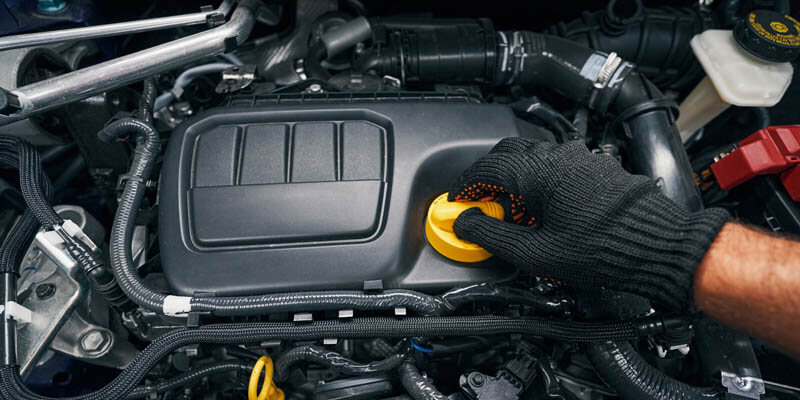Power steering fluid leaks can cause a lot of damage and performance deterioration of the engine. It is always wise to clean it up whenever you see the fluids spill out.
The cause of this spillage can be due to two reasons; first, it can be a human error; splashing liquid while refilling the reservoir must be taken into account.
Secondly, it could be a faulty hose that transfers the steering fluid. In that case, you could see your engine flooding with an oily substance. So, how to clean power steering fluid off engine? We came up with this article to let you know what can be done in such a dire situation.
Prime Causes of Power Steering Fluid Leak
The hydraulic liquid is always pumped towards the steering gear using a hose. The most common issue with leakage is due to an impaired pipeline. Coolers in the steering compartment can also cause some sort of leakage.
You can also find worn-out seals on the steering system, leading to flushing out of liquids. As you connect the hose to the metal ends, the high pressure within the piping can cause some wear and tears leading to leaking of steering fluids.
Effective Ways to Clean Power Steering Fluid
It is advised by the professionals that you don’t use any random liquid cleaner or detergent. Doing so might hinder the engine function as they are very sensitive.
Engines work best when you use safe products that are made for engine cleaning purposes. For example, the ideal way to efface steering residues from the engine is by using the following methods –
Method #1 – Engine Degreaser
We highly recommend the degreaser because it is the best cleaning solution for your car engine. Follow the link to know about some of the best engine degreasers. Let us take a look at how you can use this product step by step –
Step 1: Clean the Top
You must remove the dust specs from the engine top before applying the degreaser. Use a brush to wipe away the unwanted dirt and debris. Degreasing agents work best when there are no external twigs on the surface.
Step 2: Cover the Wirings
You must shade the connectors and cover fuses at all costs. You don’t want to contaminate these areas with spraying liquid. Make sure there are no exposed spark plugs or wires. Covering all the external wires is a safety precaution here.
Step 3: Pre-Heating the Engine
Before you start with the degreaser, you should start your car first to heat the engine. A heated engine will make the cleaning easier. Run it for 5 minutes and later turn off the engine and go on to apply the degreaser.
Step 4: Apply the Solution
Now that your engine is heated up, try out the degreaser solution. Start by spraying it onto the affected areas. You don’t have to wipe the solution; you can let it sit for 5 minutes to start the chemical reaction.
Then lastly, you need to water out the chemicals using a hose. Spray water thoroughly to take off the degreasers. Your car engine should look new in no time.
Method #2 – Using Car Shampoo and Pressure Washer
Another effective way to make the engine shine is by using pressure washers. You must be delicate using this particular process as a pressure washer will induce high-pressure flow on the engine components; there are chances of damaging some parts unknowingly.
Follow these steps to know how to use a pressure washer successfully –
Step 1: Turn Off the Engine
Make sure the car engine is turned off before you go on with the washing. Keeping the engine on will end up in disappointment and compromise the safety. Once you’ve done that, move on to cover the engine battery and all other wires nearby.
You don’t want to wash out the wires as it can cause a short circuit. Always keep the wires and battery covered when you use the pressure washer.
Step 2: Use Shampoo for Cleaning
You don’t want to be using a pressure washer just like that. It’s best to work it out with a cleaner-like shampoo. Check out some of the best car wash soaps available on the market.
Apply the cleaner to the affected area and use a soft bristle brush to dig out the frothy substance and nitpick the grimes from the surface. Once you are done, let the solution rest for 5 minutes before moving to the next step.
Step 3: Apply Pressure Washer
Now it’s time to clean spilled power steering fluid on engine. Use the pressurized stream of water on the engine surface. Don’t go hard with the flow; let the residues go off by using adequate force. The force of the water should automatically perform magic. Once you are done, let it dry out and see the difference.
Method #3 – Alcoholic Liquid
Another way to go about it is by using an alcohol solution. However, it is a bit risky and can chew up some electronic components or cause fire sparks. You can use it safely if you follow the guidelines mentioned below –
Step 1: Turn Off the Car and Wipe the Surface
First and foremost, you need to disconnect the power source of the battery and make sure your car is not on ignition. After that, you must clean the upper layer with a cloth or brush to remove all kinds of dirt and dust.
Step 2: Dab the Alcohol Solution
Keep in mind that you should not apply alcohol formulas directly to a surface. You need to put the solution on a cloth and mildly dab the affected area. Please do not use too many solutions as it is highly reactive.
Step 3: Final Touch
Alcohol tends to evaporate at a blistering pace; you need to make sure you use a cloth to utilize the wetness and efface all the grimes effectively.
FAQ
The best way to know about leakages is to check the reservoir liquid level. If you observe that your car needs frequent refilling of steering fluid, you probably have a leakage in the system.
To clear the bottom filter, refill using a new power steering fluid. Next, you need to use compressed air to blow off the dirt on the filter. Check out for remaining particles by using a flashlight. Now to replace the reservoir, you must follow the instruction manual for the ideal outcome.
Yes, it can! Many cars nowadays won’t accommodate excessive liquid; this can tamper with the reservoir and have a flowy end.
Power steering fluids are not considered flammable. Keep in mind that it does burn out at certain temperatures.
Conclusion
If the fluid in the steering reservoir spills out, it will cause the pump to run dry and thus take a toll on your engine performance by heating the engine, and soon, you may have trouble with the power steering.
So, it is advised that you check out for possible leaks and practice how to clean power steering fluid off the engine to keep your car in healthy shape.
It’s not that tough of a job, all you need to do is follow the steps and procedures we mentioned above, and you will be shining your engine and bringing your steering back to life in no time.


